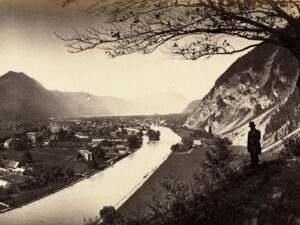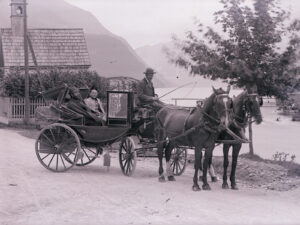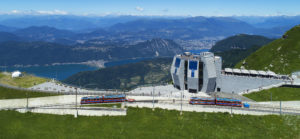
Monte Generoso Bahn
When Dutti bought a mountain railway
Towards the end of the 19th century, Switzerland experienced a boom in mountain railway construction. One of these projects was the Monte Generoso railway, opened in 1890. But the railway only survived with the help of a well-known patron.
The little train crawls laboriously from the valley station at Capolago towards Monte Generoso. Lake Lugano glitters far below to the right; the coloured houses get smaller and smaller. The noise is deafening, making normal conversation impossible. But there’s no need for talking, because the view is breath-taking. There’s no argument about that.
Up into the mountains by the power of the steam train – that was the vision of the railway pioneers in the 19th century. Switzerland was right at the forefront of this innovation, putting Europe’s first mountain railway, the Rigibahn, into operation in 1871. It was a standard gauge railway using a 1435 mm track gauge – other track gauges had not yet been licensed – and the mechanical system patented by Swiss engineer Niklaus Riggenbach (1817-1899) in 1863. The Rigibahn inspired numerous projects throughout Switzerland. The country experienced a veritable mountain railway boom: by 1913, 51 mountain railways had been built, including the Jungfraubahn designed by the Zurich-based Oberländer Unternehmen and engineer Guyer-Zeller (1839-1899), which was opened in stages between 1898 and 1912. Tourism experienced its first heyday, providing employment for 80,000 people.
Today, there are only 30 genuine rack railways left in the world – 17 of them are in Switzerland, and the Monte Generoso railway is one of them!
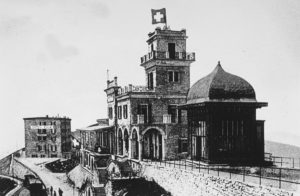
A picture postcard from 1909 shows the grandiose buildings on the mountain.
Archiv MGB
A hotel at the halfway point
The railway to Monte Generoso, 1701 m above sea level, was one the fruits of this boom. In 1870 Carlo Pasta, a local doctor, had built the Monte Generoso Bellavista hotel halfway up the mountain. The building was close to the present-day mid-point station and could only be reached on foot. Pasta, however, had bigger plans and in 1874 he submitted a license application for a railway – it was to pick up guests in Mendrisio on Lake Lugano and bring them to his hotel. But the project turned out to be too expensive and was not carried through.
A second attempt was more successful: in 1886, the railway received the license it needed from the Federal Council. Construction began under the direction of engineer Roman Abt (1850-1933). The railway was opened on 4 June 1890. Everything was Made in Switzerland. The Swiss Locomotive and Machine Works (Schweizerische Lokomotiv- und Maschinenfabrik) in Winterthur supplied six cogwheel steam engines, and SIG in Neuhausen (Schaffhausen) provided the carriages. It was only in 1982 that the railway was electrified. Prior to that, the locomotives were powered by coal and later by diesel.
The single-track railway line is 8.9 kilometres long. Unlike the Rigibahn, it uses an 800 mm gauge, making it a narrow-gauge railway. It uses the rack-and-pinion system invented by Roman Abt – a contemporary and rival of Riggenbach – which can handle gradients of up to 22%. The Pilatusbahn railway, opened in 1899, managed more than double that, at 48%.
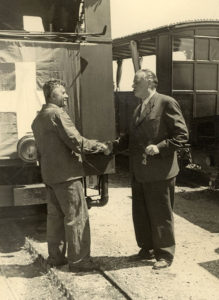
Gottlieb Duttweiler (right) bought the bankrupt railway line in 1941.
Archiv MGB
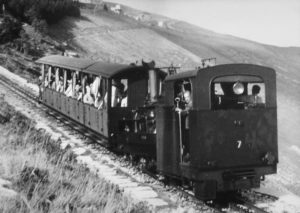
Until 1954, the train only used steam engines like this one. After that it used diesel to go uphill, and the railway was electrified in 1982.
Archiv MGB
There were moments of splendid pomp: Queen Margarethe of Spain and the Crown Prince and later King of Italy, Vittorio Emanuele III, are said to have been guests in the early days. Financially, though, things weren’t going smoothly for the Monte Generoso railway. From the beginning, the numbers remained well short of expectations. On the one hand, this was due to the railway’s geographical location on the edge of Switzerland; on the other, World War I threw a spanner in the works. In 1914 the railway operators filed for bankruptcy. Two years later a new company was started up, and in 1921 there was an increase in capital.
On the eve of World War II, the whole story was repeated, and plans were even considered to dismantle the tracks and sell the raw materials as commodities. Migros founder Gottlieb Duttweiler heard about this, and in 1941 he bought the railway. It fitted with his company strategy and helped enhance Migros’ image. Dutti cut fares and enabled families to travel to Ticino at little cost during the war. The first Migros laundry detergent, Generoso, and the triangular Monte Generoso cake were sold in the company’s shops.
Today, the Migros-Genossenschafts-Bund owns the railway. It covers not only the annual deficit of an unknown amount, but also takes responsibility for investments in track infrastructure and rolling stock. These costs are paid via the Migros Culture Percentage. Despite this generous support, the company experienced a major setback in 2010: due to subsidence of the bedrock the Hotel Veta, built in 1970, had to be closed down. For the new project Ticino architect Mario Botta, who lives just a few kilometres from the valley station, was enlisted. With his ‘Fiore di Pietra’, opened in 2017, he created a building that has become an architectural landmark on the world stage.
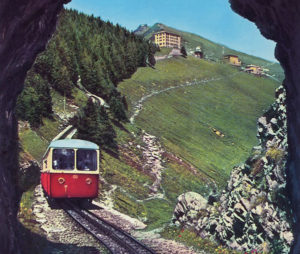
A diesel train descending the mountain, circa 1960.
Archiv MGB

